#Ubasute
Explore tagged Tumblr posts
Text










‘The Ballad of Narayama’ (1958). Directed by Keisuke Kinoshita.
7 notes
·
View notes
Text




The Ballad of Narayama | 楢山節考 (1983) dir. Imamura Shohei
#movie stills#cinematography#film stills#japanese cinema#80s#drama#family drama#ubasute#the ballad of narayama#楢山節考#imamura shohei#shohei imamura#ogata ken#sakamoto sumiko
0 notes
Text
"𝐓𝐡𝐞 𝐒𝐞𝐚 𝐨𝐟 𝐭𝐫𝐞𝐞𝐬"
My book review of the book Suicide Forest. I'm not condoning/advising/encouraging anyone to go to Aokigahara forest in Japan for the purpose of committing suicide, but my book review is about this particular forest that is associated with death, suicide. I'm not trying to sensationalize Aokigahara forest or make it seem appealing to anyone that is depressed, anxious, mentally ill, vulnerable and sensitive to the energy, presence, influence of spirits, demons such as Yurei, Onryo, Yokai, Shinigami. Death, suicide, suicide pacts is a sensitive topic that should be treated with respect. You should respect a person's choice to live and die on their terms, or their choice, reasons or motivations to commit suicide, I don't believe it is a cowardly, or selfish act to commit suicide, I've always believed that it takes a lot of courage to commit suicide, I respect anyone's choice to commit suicide on their own terms, but that is just my opinion. There is a difference between Seppuku (ritualistic, honourable self-sacrifice) and Shinju (a suicide pact between a group of like-minded people that seems impulsive, reckless and it's not considered a honourable self-sacrifice for the greater good in the same way as Seppuku is) I'm not going to judge or shame anyone for wanting to live and die on their terms, or their reasons, motivation for committing suicide either, but that is just my opinion.
Book Review
1 note
·
View note
Text

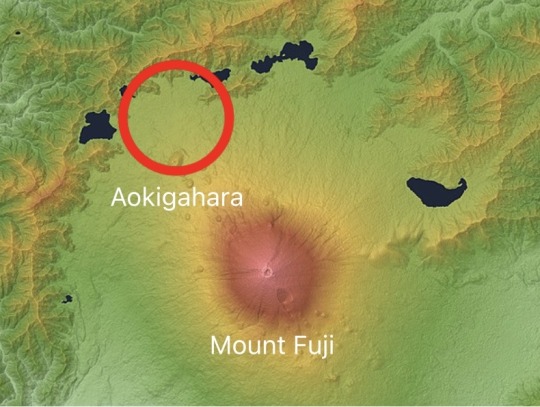
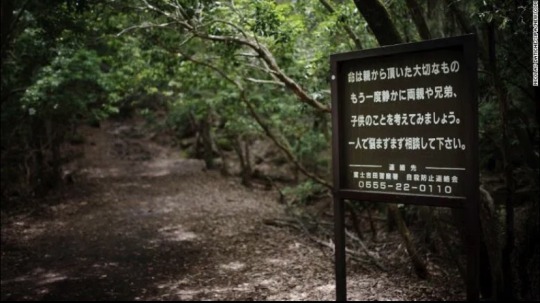
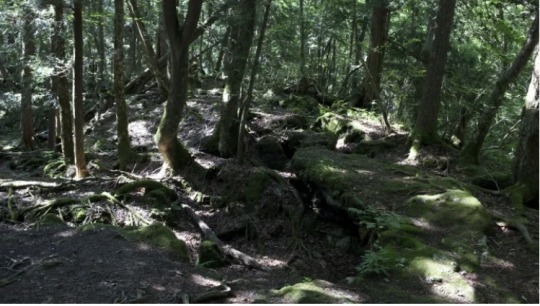
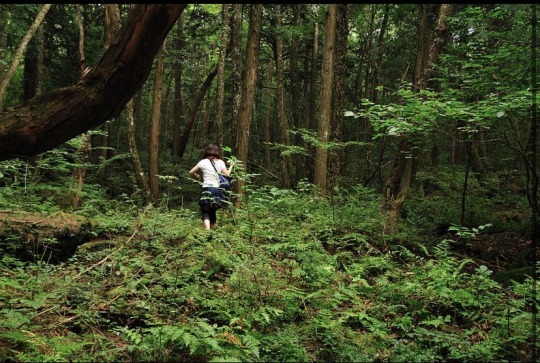

Aokigahara Forest, Japan. Aokigahara is forest located in Yamanashi Prefecture on the island of Honshu, Japan. It is on the Northwestern flank of Mount Fuji. It’s also known as the “Sea of Trees”. Although it’s a popular destination for tourists, the forest is historically associated as a popular destination for suicides, earning it the nickname “Suicide Forest”. Every year, dozens of people venture into the forest with the intention of taking their own lives. Some claim it’s between 30 to 100 each year. It’s gotten to the point where the government had stopped publishing the statistics in order to prevent further deaths. Signs have been posted along the trails encouraging those considering ending their own lives to think of their families and call a suicide prevention association. Every year, teams are assembled to comb the forest for bodies.
Japan has a long tradition of suicide as an honorable practice. For example, Samurai practiced seppuku - a ritualistic suicide method by plunging a blade into their abdomen and disemboweling themselves, followed by decapitation as an act of mercy. Samurai performed this to prevent themselves being taken prisoner or restore lost honor. According to folklore, the forest was also used in the practice of Ubasute. This was practice of taking an elderly relative into the wilderness during times of hardship or famine and abandon them to the elements, where they would die of exposure or starvation. There is, however, no evidence that this ritual was actually practiced. Suicide rates in Japan spiked during the financial crisis in 2008, and have risen again in recent years. The most common method used in the forest is hanging. According to legend, Aokigahara is also haunted. It’s said that the forest is inhabited by yūrei - vengeful and evil spirits of the dead who lure travelers off of the path and lead them to get lost and disoriented, or encourage them to take their own lives. They are said to be the ghosts of suicide or ubasute victims. According to myth, Yūrei are created if a person dies a sudden or violent death, dies with strong negative feelings like rage or depression, or is not buried properly.
Adding to tense atmosphere, is the condition of the forest itself. It’s very easy to get lost in the forest. The trees are incredibly dense in some places, and the ground consists of porous lava rock that absorbs sound, making it both very quiet and difficult for sound to travel. It gives this place a very isolated feeling. The soil has a high iron content that interferes with GPS and cell phone signals. There are some who claim that compasses have malfunctioned and only spun in circles. This, however, is regarded as false. The dense foliage can block light from reaching the forest floor, hiding rocks and roots from view.
If you, or anyone you know, is considering suicide, please know that you are not alone out there. There are people who can help you. If you’re considering taking your own life please contact a suicide prevention helpline. Numbers for various crisis hotlines can be found below. Help is out there.
United States: 988 Suicide & Crisis Lifeline, 988; Trans Lifeline, 1-877-565-8860; The Trevor Project, 1-866-488-7386; Veterans Crisis Line, 988 press 1
United Kingdom & Ireland: Samaritans, 116 123
Canada: Talk Suicide, 1-833-456-4566; Trans Lifeline, 1-877-330-6366
Australia: Lifeline, 13 11 14
New Zealand: Samaritans, 0800 72 66 66
Japan: TELL Japan, 03-5774-0992; Childline Japan, 0102-99-7777
33 notes
·
View notes
Text
El bosque de los suicidios
El lugar que se ha llevado miles de vidas.

Se encuentra ubicado en la base del monte Fuji, Japón. Tiene por sobre nombre Jukai, o mar de árboles y es conocido por ser el lugar donde las personas deciden terminar con su vida

En sí mismo es un hermoso pero denso bosque de árboles que, por su espesura, puede ser fácil perderse en él. A lo largo de los años, este bosque ha ganado notoriedad como un lugar donde individuos han ido para cometer suicidio. Se estima que cientos de personas han entrado en el bosque con la intención de acabar con sus vidas, y algunos no han sido encontrados.

La razón detrás de la elección de este lugar es multifacética. Algunas personas consideran que la densidad del bosque ofrece privacidad y aislamiento para llevar a cabo sus planes sin ser interrumpidos. Además, la oscuridad y la tranquilidad del lugar pueden ser atractivas para aquellos que buscan la soledad en sus últimos momentos.

El gobierno japonés y varias organizaciones han trabajado para tratar de disuadir a las personas de tomar esta decisión fatal. Se han colocado señales con mensajes alentadores y se llevan a cabo campañas para promover la conciencia sobre la salud mental y ofrecer ayuda a aquellos que enfrentan problemas emocionales o psicológicos.

Es importante mencionar que el bosque en sí mismo no es la causa de los suicidios; más bien, es un lugar que ha ganado fama por esta triste razón. La problemática del suicidio es compleja, y requiere atención y comprensión desde una perspectiva más amplia que abarque la salud mental, el apoyo comunitario y el acceso a servicios de salud adecuados.

Si estás lidiando con pensamientos suicidas o conoces a alguien que pueda estar en esa situación, es fundamental buscar ayuda profesional. En Japón y en muchos otros países, hay líneas de ayuda, terapeutas y organizaciones dedicadas a brindar apoyo a aquellos que luchan contra estos sentimientos.
Es importante abordar el tema del suicidio con compasión, comprensión y cuidado, fomentando entornos y recursos que promuevan la salud mental y el bienestar emocional.

Algunos piensan que la fama de este bosque como un sitio de suicidio tiene raíces que datan del siglo XIX, con prácticas como la "eutanasia" japonesa, donde se cuenta que familias pobres abandonaban a sus ancianos o parientes enfermos en el bosque para morir, en un acto conocido como ubasute. Además, la literatura también ha contribuido a la fama de este lugar. Obras como "El manual completo del suicidio" de Watary Tsurumi, publicado en 1993 y actualmente prohibido en el país, así como "Nami No Tou" de Seicho Matsumoto de los años sesenta, donde una pareja decide acabar con sus vidas en el bosque, han convertido al bosque en uno de los escenarios preferidos por los japoneses para poner fin a sus vidas.

2 notes
·
View notes
Text

aokigahara forest
aokigahara means sea of trees in English. This forest wasn’t negative at first but in 1960s it was know for the many suicides, eventually it got the nickname of suicide forest it’s is also the most used area for suicides. The photo below has been added due to the suicides that happen it says
Life is a precious gift given to us by our parents.Let's once again quietly think about our parents, siblings, and children. Don't worry about it alone
Below it say contact Suicide Prevention Association .
In Japan it’s a famous place for suicides. in 2003, 105 bodies were found in the forest exceeding the previous record of 78 suicides in 2002. In 2010 the police recorded 54 confirmed suicides and 200 attempts of suicide
The ways people took there life in the forest by overdose or hanging.
history of suicide in Aokigahara predates the novel's publication, and the place has long been associated with death ubasute may have been practiced there into the nineteenth century, and the forest is reputedly haunted by the yūrei of those left to die
The meaning of ubasute : which means abandoning old women whereby an infirm or elderly relative was carried to a mountain, or some other remote, desolate place, and left there to die
The meaning of yūrei : soul or spirit
Also this place is close to Mount Fuji


1 note
·
View note
Text
TOTOXL | Hutan Aokigahara, neraka di belakang Fuji
Menjelajahi Misteri Hutan Aokigahara: Kisah Horror yang Mengguncang
TOTOXL Di Jepang, terdapat sebuah tempat yang telah menjadi legenda urban dan menimbulkan ketakutan yang mendalam: Hutan Aokigahara. Terletak di lereng Gunung Fuji, hutan ini dikenal dengan sebutan "Hutan Bunuh Diri" karena reputasinya sebagai tempat yang sering dipilih oleh orang-orang untuk mengakhiri hidup mereka. Namun, di balik reputasi tragisnya, terdapat kisah-kisah horor yang membuat bulu kuduk merinding.

Jika di Indonesia, hutan paling mengerikan merupakan alas Roban, hutan yang konon katanya merupakan dinasti iblis tertua, maka di Jepang tak kalah mengerikan, ada sebuah hutan bernama hutan Aokigahara yang menjadi tempat bunuh diri sebagian orang depresi di Jepang, karena hutan ini benar-benar indah, sendu, kelam dan dingin, membuat siapapun yang membayangkannya ingin menyatukan diri padanya.
Hutan aokigahara bukanlah sebuah hutan biasa, ia terletak di bagian belakang Gunung Fuji, gunung indah di Jepang yang membuat siapapun sangat tenang melihatnya, namun dibalik keindahan dan kenyamanan, siapa sangka bahwa setiap tahunnya ditemukan ratusan tengkorak di dalam hutan itu? Hari ini kita akan membahas hutan Aokigahara secara lengkap, sudah siap? check this out!
Latar Belakang hutan Aokigahara
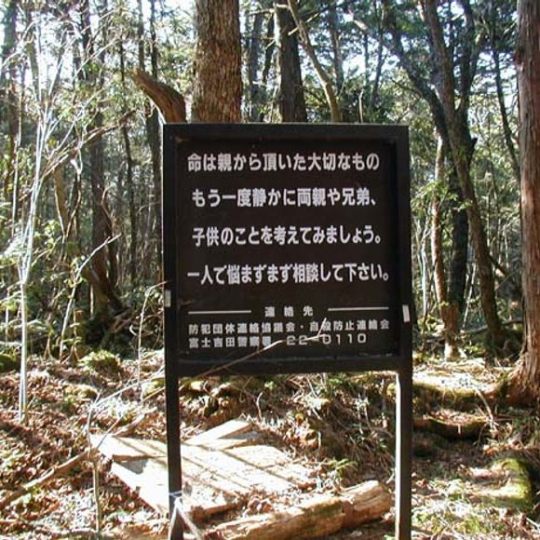
Hutan Aokigahara memiliki sejarah yang kaya dan misterius. Menurut legenda, hutan ini merupakan tempat di mana orang-orang kuno melakukan ubasute, sebuah praktik di mana orang tua yang tidak diinginkan ditinggalkan di hutan untuk meninggal secara alami. Selain itu, hutan ini juga dianggap sebagai tempat ritual spiritual dan mitologi Jepang.
Aktivitas Paranormal di hutan Aokigahara
Banyak pengunjung dan penduduk setempat melaporkan pengalaman supranatural dan aktivitas paranormal di hutan ini. Suara-suara aneh, bayangan-bayangan yang muncul secara tiba-tiba, dan perasaan kegelapan dan kecemasan telah didokumentasikan oleh banyak orang yang memasuki hutan ini. Beberapa bahkan mengklaim melihat hantu-hantu dari orang-orang yang bunuh diri di sana, suara hentakan kaki dan suara mengerang dari orang-orang yang menggantung dirinya di hutan ini, beberapa ahli spiritual mengungkapkan bahwa di hutan itu ada sesosok makhluk yang mengajak orang untuk tinggal bersamanya.
Mitos dan Legenda Aokigahara
Hutan Aokigahara dipenuhi dengan mitos dan legenda yang menambah aura misteriusnya. Salah satu cerita yang paling menakutkan adalah tentang yūrei, arwah orang-orang yang meninggal dengan cara yang tragis dan terus gentayangan di hutan ini. Dipercaya bahwa yūrei dapat membingungkan dan memperdaya pengunjung, membawa mereka ke dalam kegelapan abadi.
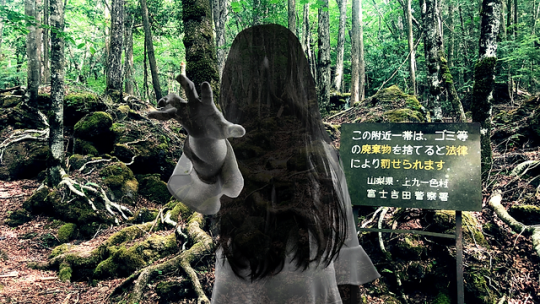
Tragedi Bunuh Diri
Namun, di balik keangkerannya, Hutan Aokigahara juga menjadi tempat yang tragis. Bukan hanya satu dua orang, namun puluhan hingga ratusan orang setiap tahunnya mengakhiri hidup mereka di hutan gelap ini. Bahkan, tim penyelamat yang ditugaskan untuk mencari dan menyelamatkan orang-orang yang tersesat di hutan juga sering menemukan mayat-mayat yang bunuh diri.
Pesona yang Membingungkan
Hutan Aokigahara terus menjadi pusat perhatian bagi para peneliti, penulis, dan pengunjung yang tertarik dengan misterinya. Meskipun pemandangannya yang indah dan alamnya yang menakjubkan, hutan ini tetap menyimpan rahasia gelap yang menakutkan. Bagi yang berani menjelajahi, Hutan Aokigahara menyediakan pengalaman yang tidak akan pernah dilupakan.

Hutan Aokigahara adalah tempat yang penuh dengan misteri dan horor. Dari legenda urban hingga aktivitas paranormal, hutan ini telah menarik perhatian banyak orang dari seluruh dunia. Namun, di balik kecantikannya yang alami, terdapat kisah-kisah yang menakutkan dan tragis yang membuatnya menjadi salah satu tempat paling angker di Jepang. Bagi yang ingin menjelajahi, bersiaplah untuk menghadapi aura kegelapan yang tak terlupakan. TOTOXL
#totoxl#toto xl#daftar totoxl#login totoxl#rtp totoxl#aokigahara#fyp#fypシ#slotgacor#daftar toto xl#login toto xl
0 notes
Text

Ubasute no Tsuki, from One Hundred Aspects of the Moon, Tsukioka Yoshitoshi
1 note
·
View note
Text
If someone were to ask the newly appointed Yondaime whether he believed in ghosts, they would be subjected to an incredulous look; complete with a raised blond brow and owlish blue hues. After a brief moment of scrutiny, said question would be waved aside with a humorous chuckle, before the conversation would inevitably be steered towards matters involving government and the appalling mess that was the archive cabinet in the Jōnin headquarters.
For you see, Namikaze Minato didn’t believe in ghosts. ‘Spirits’ to a degree, could be considered manifestations of wayward chakra signatures that had yet to fade from their plane of existence. Nothing more.
Ghosts though? Pft.
That was the only logical explanation, wasn’t it?

A frost-laden gale blew from the stormy white peaks up yonder; echoing a ghostly howl and laden with enough snow to swallow the little sunlight that had managed to flicker through the rolling fog. It was dreary, if one could describe it in a word, yet also paradoxically calm; not a soul in sight, none dumb enough - touched in the head enough - to take their chances against nature’s silent rage.
And then there was him of course; an insolent blotch of blue and gray against a backdrop of sweeping white. Blue hues chanced a peek at the charcoal-smudged skyline before disappearing under his flimsy hood - he could barely see past the blizzard, let alone focus enough to know where he was going. Near frozen fingers curled tightly around the handle of a kunai, while the other hand kept a tight hold of his traveler’s cloak. The last thing he needed was the wind to fly off with it.
The border between the Lands of Frost and Lightning was particularly hostile around this time of the year; many a peddler that he had met on his way from Ta no Kuni had warned him as much, citing near-death personal experiences so as to dissuade even the most stubborn of travelers.
Clearly, they had never met a Konoha shinobi - one on a reconnaissance mission, no less.
The Second Shinobi War was heaving its dying breaths, with Amegakure having retreated and Sunagakure having suffered the white fang, Konoha was well on its way to claiming complete victory.
Or at least they would have been. A little birdie had told the elder council of an impending attack from Kumogakure, who had apparently been waiting for the rest of the hidden villages to exhaust their resources before showing their hand.
Considering the tact of such an idea, it was smooth and simple; an effective tactic while everyone else scattered about like headless poultry. Naturally, with assets stretched thin and shinobi exhausted after 3 years of pointless skirmishes, Konoha’s war office had declared the matter worthy of looking into. The only question being a matter of who would be fast enough, smart enough, to assess the situation from a discrete angle and report back just as swiftly?
Enter one Namikaze Minato, Konoha’s resident Yellow Flash and nearly the fastest shinobi in the field. He had been given stellar recommendations by Yuuhei Keisuka, the commander of their Kusa outpost for his numerous achievements. It was also rumored that he was quite talented at some odd variation of the shunshin no jutsu, which made him annoyingly deadly on the battlefield.
For all his talent though, he was certain that he would freeze to death out here in the wilderness. Now-pale digits pulled the cloak tighter around his person at the thought, as blue orbs narrowed against the onslaught of what felt like frost-tipped pinpricks against his vision. Normally, under such circumstances, the blond would use his hiraishin (which was not an odd variation of the shunshin no jutsu, thank you very much) since it allowed him to cover more ground relatively easily; in fact, that was how he had reached the outskirts of Kumogakure in two days to begin with.
However, most of his reserves had been spent on placing his markers, and since his reconnaissance was meant to be a secretive one, he could afford no chances. The week he had spent on that altitude sickness-inducing nightmare they called the barrack backyard had mostly witnessed him teleporting from one marker to the next; gathering intel with detailed notes - infiltrating their headquarters while they slept, like a kami-forsaken, blond haired ghoul.
For all his efforts and backtracking, amidst draining his chakra reserves to the point of near exhaustion, Minato had come to one, solid conclusion.
The birdie that had so willfully whispered in the council’s wrinkly ear had clearly been suffering from a concussion. Kumogakure had no plans on entering the war, despite them having picked a bone with Konoha earlier via Uzumaki-napping gone wrong. They were squandering their resources, yes, but for another reason entirely that had nothing to do with their current skirmishes. Minato had the notes (swiped, of course, from under a commander’s upturned nose) to prove it.
Now if only he had the chakra for it too, he grumbled. The near dwindling state of his reserves at present could be attributed to his escape from Kumo’s borders - he couldn’t exactly leave a trace behind, after all. With enough intel to report back (and an outpost in sufficient disarray because they were convinced their corridors were haunted), Minato had simply wanted to put enough distance between him and a potentially explosive powder keg.
Even if that meant covering some distance via nearly frost-bitten limbs. Cue a grimace as his leg sunk further in the deep snow, the cold nearly gnawing it off from the knee. He had to wait a little while, probably just a bit more before he recovered enough chakra to use the hiraishin with his marked kunai - two dimensional hops would hopefully put him in range of the marker he had placed on a tavern that bordered the forests; a patch of thick green wilderness that lay a little distance from where the ascent to the mountains truly began.
Cue another crunch of snow which was nearly swallowed by the wind. Gloved digits abandoned his weapons pouch in favor of shielding his eyes from the additional frigid onslaught. At this rate he was going to turn into a blond-sicle and he would have no one to blame but his lack of better judgement.
Oh, and the elder council - definitely the elder council, came a childish reminder, as blue hues caught a smear of dark green somewhere in his peripheral; it stood in stark contrast to the dull hues swathing the landscape.
Forests were usually green (lets blame a frost-bitten brain for stating the obvious)…mentally trailing off, the chunin felt the beginnings of hope kindle his frozen insides and he flailed through deep snow with increased vigor. It wasn’t until gloved fingers found the brittle ridges characteristic of a Tsuga* bark that he allowed himself to slow down a little; and not until he had made decent headway into the foliage that he allowed himself to pause for breath.
Trees meant less snow (or more, if he was clumsy enough which, at the moment, seemed like a distinct possibility) and less wind, which inevitably meant better visibility. As thick as they were, they provided ample shelter, with the blizzard too busy running amuck between the heavy branches to pelt him with vision hampering flurries.
The trees also proved to be an apt backrest because kami, he was tired. The teen exhaled a large puff of breath before pausing behind a particularly sturdy tree; letting his back rest against it with a soft whump that was barely heard over the wind that was basically laying waste to the forest canopy.
Apart from that, it was relatively quiet and surprisingly less hostile. Shadows clung to an overhanging branch here, to the undersides of gnarled roots there…lurking between the trees in a way only nature could manage. His senses told him nary a soul was nearby, and with the paranoia borne of his profession eased off his shoulders, Minato felt his eyes flutter shut for the briefest moment.
He had been on high alert for so long…letting his head rest back against the trunk, the blond felt exhaustion lull his consciousness into the beginnings of a light slumber. Five minutes…maybe ten? Maybe he could just rest here until his chakra had been replenished enough for him to use the hiraishin without collapsing. Maybe–
“Could you please help me?” The words were soft, barely a whisper in the wind; but to him they were as loud as an explosive seal tag. Blue hues snapped open, and with speed borne of pure instinct, he pulled out a kunai, the deadly three pronged tip pointed at his assailant’s jugular.
Had he not been as exhausted as he was, said tip would have promptly been buried in an unsuspecting neck without a moment’s notice – but thankfully that wasn’t the case. Startled black hues stared back at him from beneath her wide brimmed kasa*, wrinkled mouth still open from her earlier request. The old lady seemed frail, her weathered hands clinging to a make-shift, gnarled staff as the breeze played around with her long ponytail.
How had he not sensed her? Blue hues narrowed, the kunai point still lingering with deadly accuracy as his heart played a thundering staccato in his ears. Try as he might, he could not pick up on the old lady’s chakra signature - either she was an exceptionally well trained scout or—
“Please” It was more of a statement than a request this time, as her clothed knees shook and she fumbled with the large stick in her hands, “My son…I can’t find him.” There were tears brimming against her beady black hues, “You look like him and I thought…” Trailing off, the old lady choked back a sob as she turned her head to her shoulder to hide her barely repressed tears, frail shoulders quaking with the effort.
Blink. He slowly lowered his kunai, her visage tugging at a stray heart-string he didn’t even know he possessed anymore (thanks to murdering child-scouts on a weekly basis); maybe she was a lost civilian after all? His senses had yet to fail him. Minato spun the kunai to rest snugly against his palm, his index finger acting as an anchor in the metal loop; before taking a step closer to her, still wary - and for all the right reasons, mind you.
“Summimasen, baa san.” He said, tone just a little warmer than the weather, “But you shouldn’t be out here, in this blizzard.”
The old woman nodded in response, rubbing her face against her sleeve before raising her head to meet his guarded expression, “My son…I just want to find him. You understand?” Of course he didn’t “But the storm and…I…I can’t find him” she flailed, “Since you’re going down…can you help an old lady a little way?” Dark hues stared at him in earnest; hopeful, yet somewhat hesitant.
Minato paused; as heartless as it seemed to simply abandon her right there and then, he was rather inclined to do so - regardless of Kumo’s stance, they were still in the midst of war and his face had recently graced the pages of every bounty scroll in the continent.
But there was something about her predicament that nagged at his conscience - also, he had probably scared her halfway to the afterlife earlier. With a short nod, he found himself extending an arm to her as additional support before he was even aware of it; only realizing the gesture once thin, spidery fingers grasped his forearm in a frigid, vice like grip. The old lady had shifted most of her weight on him, and he supposed that was understandable since she could barely hold on to the rotting branch anyways. Said branch had undoubtedly been picked from the base of the many Tsuga trees that littered the forest.
And so they walked - lumbered, in the old lady’s case - for an indefinite period of time. Minato lost track after the second time they passed a familiar tree; the sole indication of their direction based on the downward slope of the forest floor. His companion was surprisingly quiet through the trek, sans the heaving breaths that would emanate from her person.
If she was still worried for her son, she wasn’t as keen on showing it. Blond brows furrowed at the thought before it was filed away for later; his chakra was nearly at a point where he could teleport with a fraction to spare, and with somewhat replenished reserves, he was more aware of the faint chakra of living matter buzzing about the forest. It was noisier than natural energy, which flowed more like a constant stream; though what bothered him was the fact that the old lady emanated neither.
Maybe it was because he wasn’t as adept at sensing natural energy yet? Regardless, if he was going to use the hiraishin soon, they would need to part ways – though maybe he could bring her along? The woman was clearly no threat to his person, and maybe the tavern owner could help her locate her son?
Cue a tightening of thin fingers, as if she had heard his thoughts. Minato paused mid-trudge, blue hues trying to locate dark counterparts from the shadow of her picker’s hat, “Obaa san, there’s a small tavern dow—”
“Iie” The wind had gotten eerily quiet; a mere treble against the sharp whisper. The icy grip on his wrist curled tighter, as if to break the appendage between spidery digits. Try as he might, he couldn’t tug it away, instead, her nails painfully burrowed holes in the underside of his wrist.
With a barely withheld grimace, the Namikaze mumbled an apology, while summoning some of his chakra to the other palm before striking the woman squarely in the chest; a controlled gust of wind - usually strong enough to send a grown shinobi flying - erupting from his hand.
It barely disturbed her kasa “You promised” her voice was hollow, almost an echo from a great unseeing void. Ravenous inky tendrils flowed like a gushing torrent from beneath her hat, wrapping tightly around his midsection and slowly snaking upwards; frost tipped points numbing flesh as they did.
By the shodai’s eyebrows— Minato almost swore, before he dangerously flicked the kunai from his caught hand, the steel points doing little to hamper her grip on his wrist. The woman cocked her head to the side, before empty hues found his near panicking ones, causing him to freeze mid-struggle.
Gone was the friendly face; the crow’s feet, wrinkled mouth and the sagging skin. Instead, there was rotten flesh, with maggots peeking from empty sockets that sat snug between layers of decaying, mottled crimson; no doubt decomposing muscle. A strip of flesh hung loosely from one cheek bone as her gaping maw opened wide, barely strung together by fleshy ribbons.
“You promised”
Move, Namikaze – this is a genjutsu. It has to be a genjutsu – but even amidst his panicked thoughts, he couldn’t move a single muscle. The hair had him constricted to the point of suffocation; he could barely concentrate on gathering his chakra together.
Move, Namikaze! The inky tendrils caressed his cheek now, deceptively gentle as the marred face came closer. Minato felt the breath escape his lungs as bony fingers inched towards his eyes. Quivering digits barely managed to flick the kunai in his hand uselessly behind the apparition.
Move! He was a gray blur at the faintest prick to his cheek. His form disappeared from between writhing strands; only to appear behind her. Blue hues barely registered the inky tendrils in his peripheral before he summoned every last bit of chakra and flickered to his last marked signature—
—And promptly crashed into a table full of delicate china; complete with ink sticks, empty brass scroll holders and rolls of parchment. Spots danced across his vision, as his eyes strained to accustom to the suddenly new, darker environment. Breathing heavily, the blond chunin barely managed to pull himself out of the splintered wood and broken ceramic; quivering knees and fingers resting heavily against the aged tatami.
The room tilted sideways, and Minato was sure he would have tilted with it had it not been for a squeak that prompted his gaze.
“W-Who?” An old man was huddled away from him, clutching a short tanto blade to his chest as if the presence of the weapon alone would ward off danger. Blue hues blinked dully at it before flickering to the dim lamp light reflecting off the man’s pale scalp.
Thank kami he was bald. Cue a faint, watery grin before chakra exhaustion took its toll and he dropped to the side like a sack of daikon - just as the man let out a particularly high pitched shriek.
Needless to say, by the time he got back to Konoha, he was considerably poorer than when he had left.

Namikaze Minato didn’t - wouldn’t believe in ghosts. Kato Dan had once explained the idea behind the stereotypical ‘specter’, as the image, once popularized by veteran war narratives, would be enough to build a reputation. Dan had relied on that image, since not only did it compliment his famed Spirit Transformation technique, but there was no weapon more feared than a reputable shinobi.
As Yondaime, Minato had all that and more - for a man on the pinnacle of his career, he couldn’t afford to give in to idle fancies.
Even though at times, during the frostiest winter nights, he felt the familiar touch of spidery digits curling tightly over his wrist; a forgotten name a mere whisper in the wind.
Tsuga = Japanese Hemlock trees Kasa = rice picker’s hat
#Minato#The Surreal#headcanon#so I delved into Kafka again and decided; why not#Second Shinobi War#From the Yondaime's Personal Archives#Ubasute#v; yondaime#Yondaime#that moment when you realise that the yellow flash was 14 when he got the title#Namikaze Minato#minato namikaze
4 notes
·
View notes
Text
Ubasute
Dans ce court et émouvant premier roman, Isabel Gutierrez raconte comment un fils exauce le vœu de sa mère de mourir sur une montagne. Une ultime ascension d'une grande richesse.
En deux mots Pierre a décidé d’exaucer le vœu de sa mère et de la transporter vers le sommet de la montagne pour son dernier voyage. Tout au long de l’ascension, il va évoquer avec elle leurs souvenirs, leur histoire familiale. Ma note ★★★ (bien aimé) Ma chronique En route pour le dernier voyage Dans un court et émouvant premier roman, Isabel Gutierrez raconte comment un fils exauce le vœu de…

View On WordPress
#Amour#ascension#beauté#cruauté#décès#Famille#fils#Japon#Maladie#montagne#Mort#Personne âgée#relation mère-fils#tradition#Ubasute#vitalité#Voyage
0 notes
Photo

Em um tempo muito distante no Japão, havia uma prática chamada UBASUTE, que pode ser traduzido como "abandonar um idoso". Esse fenômeno já foi uma prática em alguns períodos da história japonesa. Principalmente em épocas de escassez de alimentos e recursos básicos. O UBASUTE é uma prática onde os familiares mais jovens levam seus parentes idosos para um local isolado e os abandonam para morrer. Normalmente em florestas e ambientes naturais. Vale lembrar que nem sempre a decisão de abandonar um idoso partia dos mais jovens. Conscientes de que se tornaram um fardo e da necessidade de suas famílias, os próprios idosos convenciam seus familiares a abandoná-los. No mundo temos aproximadamente 1 bilhão de pessoas com mais de 60 anos, muitos deles com problemas de saúde como: Derrames (acidente vascular cerebral); Pneumonia; Câncer; Enfisema e bronquite crônica; Infecção urinária; Osteoporose; Diabetes; Osteartrose; Mal de Parkinson; Alzheimer. Entretando, muitos desses idosos são sustento do lar, seja com o salário, ou com a aposentadoria. Muitos cuidam dos netos para que os filhos possam sair para trabalhar. Não existe triunfo sem perda, não há vitória sem sofrimento e nem liberdade sem sacrifício. A vitória pertence aquele que acredita nela por mais tempo. Cada minuto que passa é uma nova chance para mudar tudo para sempre. Podemos sair todos da quarentena, crianças, jovens e idosos, e acreditar que Deus é Brasileiro, e que as condições climáticas, e que os hábitos de higiene pessoal, e que temos anti-corpos para barrar o Sars-Cov-2 e suas variações, com uma baixa de 5 mil pessoas, salvando outros 200 milhões de total colapso financeiro, ou cumprir a quarentena por mais alguns dias, e torcer para que os números estejam certos, e que o vírus está diminuindo a velocidade de contágio, e que antes do início do frio no Brasil, teremos controlado o contágio e as mortes. Não há garantias, teremos que apostar. Qual é a sua opinião ? Convide seus amigos para essa reflexão! #ubasute #idosos #coronavirus #covid19 #colapsofinanceiro #escolha #deusébrasileiro #quarentena #escolha #triunfo #Sars-Cov-2 #moinhovelho (em São Paulo, Brazil) https://www.instagram.com/p/B-LoKFTFqkf/?igshid=1lfoi0vtewthq
#ubasute#idosos#coronavirus#covid19#colapsofinanceiro#escolha#deusébrasileiro#quarentena#triunfo#sars#moinhovelho
0 notes
Link
#Ubasute#obasute#senicide#Monte Fuji#Aokigahara#folklore#leyendas#japonés#viejos#enfermos#abandonados#ancient origins#history#japan#japon#tradition#myth#mythology#mitología
0 notes
Text
White hat-sandakada pahana aka moonstone - After Effects animation
blue hat-Ra- blender + 2D
red hat-The Legend of Cailleach - mixed media
green hat-Idun is the goddess of youth and the golden apples- stop-motion
Hebe goddess of youth Cupbearer to the Gods- 3d molding and aftereffects
yellow hat- tbd
black hat-Japanese Ubasute- charcoal animation
0 notes
Text
Ubasute: Carrying Life to Death’s Mountain
Ubasute: Carrying Life to Death’s Mountain
I listen to his wheezeand watch the machine ascendfor a full breathe thenfall back down againand know I must trek to the mountain once again.Like my mother, heedless of self and for my sake, will he snap twig after twig to point my safe return?She died clutching a small cross,a loblolly branch,her bones resting on Appalachiansoil, open to the sky and animals delightlike her ancestors.She was a…

View On WordPress
1 note
·
View note
Photo





Hiroshige Utagawa's "Month of Shinshu Sarashina". The place is at the foot of Mt. Ubasute in present-day Chikuma City, Nagano Prefecture. It has been known as a famous place for the moon since the days of Manyoshu. There is a beautiful full moon in the cloudless sky. The phrase "Thousands of miles beyond the moon and rice fields" is added. Text by Ota memorial Museum of Art
151 notes
·
View notes
